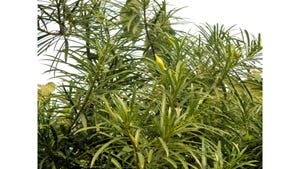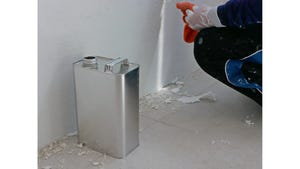Optimizing the Lifetime Cost of Hoppers
April 21, 2009
By Tim Freeman
|
Figure 1: A plot of FF and ff showing the intersect point defining the flow/no flow transition for potato starch |
The methodologies developed by Jenike in the 1960s remain the standard for hopper design and are used extensively across a diverse range of manufacturing industries. Unfortunately, many process engineers remain uncertain as to how to measure powders and develop a successful specification from the results. It is therefore common to outsource both hopper design and the material testing associated with it.
Modern powder testers simplify measurement, making it easier for nonexperts to precisely determine key powder properties and make use of such data to calculate the optimum design parameters for a hopper. New software for such systems brings hopper design within the remit of most process engineers, guiding users through measurement and application of the Jenike method. This provides an opportunity to take control of powder testing and to understand the implications of the results for both design and operation. Developing such knowledge encourages better specification, facilitates the reuse of existing units for new applications, and promotes an intelligent approach to troubleshooting.
The extent to which the 'key powder properties' may change is a crucial question that can now be addressed before the design is completed. The effects of aeration, deaeration, permeability, moisture content, or fines, for example, need to be taken into account so that the inherent variability of powders can be allowed for or, at the very least, anticipated. The modern universal powder tester can provide this information, which will be the subject of a future article.
The Basic Principles of Hopper Design
In what follows, the term 'bin' refers to the section of a storage vessel with parallel sided walls; 'hopper' is the angled portion below. Whatever the size or shape, the design intent for storage silos is always the same: reliable, steady powder discharge at the required rate. Outlet size and hopper half angle (the degree of incline from the vertical of the hopper walls) are specified to achieve this aim, based on the properties of the powder and material of construction. The flow regime that develops in the vessel can be classified broadly as either mass or funnel (core) flow—mass flow being the usual design intent.
With mass flow, all the powder is in motion as material is withdrawn at the exit, producing a 'first in, first out' regime. Flow tends to be relatively consistent and the full capacity of the bin is used. With funnel flow, on the other hand, there is an active channel down the center of the vessel, but powder stagnates along the hopper and bin walls. Funnel flow produces 'last in, first out' powder delivery and a greater likelihood of operational problems, such as rat holing, segregation, and flooding, but it can be the preferred choice when, for example, building height is limited. Funnel flow designs are shorter and wider than mass flow units accommodating an equivalent volume because the hopper walls are of a shallower angle.
Design Theory
Jenike's design methodology is derived from a detailed flow analysis of the hopper at the transition point from flow to no-flow1,2. Powder discharge ceases if a stable arch forms across the outlet that can sustain the weight of the bed above it. Whether this occurs or not depends on the shear properties of the material, the size of frictional forces between the powder and the material of construction, and compressibility, i.e., the change in bulk density caused by consolidating stresses.
In summary, the design technique involves determining two parameters: flow function (FF) and flow factor (ff). FF depends purely on the shear strength of the powder, which is measured as a function of applied normal stress using shear cell apparatus. The torque or force required to shear a consolidated powder bed across a plane is accurately determined to generate yield loci for the material, from which FF is derived3.
Flow factor, ff, in contrast, depends on characteristics of the hopper, such as material of construction and shape, as well as properties of the powder. For any specific hopper configuration it is a function of hopper half angle, wall friction, and material bulk strength. Wall friction angle is measured by shearing the powder against a sample of the material of construction. Figure 1 shows a plot of FF and ff for the design of a conical silo for potato starch, made from Type 316 stainless steel with a surface roughness of 1.2 µm.
The point at which the FF and ff curves intersect quantifies the stress in a hypothetical arch across the hopper outlet, at the transition point from flow to no-flow. The design process is iterative and in this case produces a value of 1.86 kPa for stress in the arch, and a hopper half angle of 15°. Inputting these results into the equation below, which derives from a simple force balance on the arch, suggests an outlet size of 0.59 m.
Β= σ1Η (α)
11ρg11
Where
B is the outlet diameter (meters).
σ1 is the consolidated stress generated in an arch at the outlet (kPa).
H(α) is a function that takes account of variation in the arch thickness, hopper half angle, and hopper geometric configuration.
ρ is the bulk density when consolidated at σ1 (kg/m3 or g/ml).
g is the acceleration due to gravity (9.81 m/s2).
Standard practice is to decrease hopper half angle by 3°, i.e., make it steeper than the analysis suggests, and increase outlet size by 20%, to provide a margin for error. Both actions improve the likelihood of uninterrupted mass flow from the hopper. This gives design parameters for this example as follows:
Hopper half angle - 12°
Outlet size - 0.71 m
Optimizing Long-Term Operation
This method establishes the two critical dimensions required for equipment specification for a unique hopper containing a powder with the specified shear properties. Changes to any of the variables used to determine ff and FF will impact the results obtained. So, for example, if the hopper is used for an abrasive material that gradually changes surface roughness, with time the design will become suboptimal, potentially not operating as well. Unfortunately, the scope for powder properties to change is a much larger, less easily quantified problem.
A number of factors can change the shear properties of a powder including segregation, attrition, changes in moisture level, and consolidation time.
With segregation the powder separates on the basis of size so the hopper may have to cope with slugs of coarser and finer material, rather than a homogeneous blend with a broader particle-size distribution. Typically, fine materials are more cohesive than coarser ones so the design fails when the level of fines becomes too high, creating a blockage. Attrition also increases the amount of fines and can produce operational problems in the same way.
Moisture level is widely recognized as an important determinant of powder properties but sensitivity and the impact on hopper performance varies. Perhaps less appreciated is how powders can consolidate over prolonged periods when stored under their own weight, developing higher shear strength. Where this is an issue, a weekend shutdown with a full silo for example may cause problems on a Monday morning. The powder consolidates and shear strength increases to the point where a stable arch forms across the hopper outlet. With particularly sensitive materials, even a change in fill level and residence time can be significant.
Because the material testing associated with hopper design is generally outsourced, there is a tendency for it to be limited and disconnected from the rest of the design process. The sensitivity of the specification is not fully scoped or understood within the context of the overall process. For example, the dependence of hopper design and operation on moisture level would be a relevant factor in determining optimal parameters for operating an upstream dryer. On a longer term basis, it is harder to confidently specify the reuse of an existing unit for a new material if there is limited opportunity for further testing and understanding. Troubleshooting is likewise compromised.
Bringing both testing and design in-house provides a tool that can be used across the lifetime of the unit to maximize its value and solve operational problems. The best powder testers incorporate dynamic testing as well as shear measurement, permitting the detailed study of, for example, the effect of aeration on powder flowability. These data, although not directly used for hopper design, can also be directly relevant in resolving hopper operability issues4.
Conclusion
New software, in combination with modern automated powder testers, demystifies hopper design—from powder testing through to specification by using well-established design methodologies. Outsourcing design, and the associated powder testing, is costly, and perhaps more importantly, undermines a company's long-term ability to maximize the value of a silo through reuse and optimal operation. Bringing the process in-house makes it easier to assess the sensitivity of the design to changes in powder properties within the context of the overall process and provides a valuable powder testing tool for ongoing troubleshooting and optimization studies.
Tim Freeman is director of operations for Freeman Technology (Worcestershire, UK). For more information, visit www.freemantech.co.uk, e-mail [email protected], or call +44 1684 310860.
References
1. AW Jenike, “Storage and Flow of Solids,” Bulletin 123 of the Utah Engineering Experiment Station, Salt Lake City, University of Utah, (November 1964, revised 1980).
2. AW Roberts, “Basic Principles of Bulk Solids Storage, Flow and Handling,” The Institute for Bulk Materials Handling Research (1993).
3. Institution of Chemical Engineers, “Standard Shear Testing Technique for Particulate Solids Using the Jenike Shear Cell.” A report from the EFCE Working Party on the Mechanics of Particulate Solids (Rugby, Warwickshire, UK, 1989).
4. R Freeman, “Measuring the Flow Properties of Consolidated, Conditioned, and Aerated Powders—A Comparative Study Using
You May Also Like


